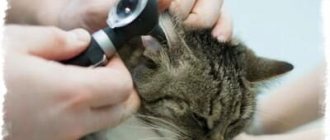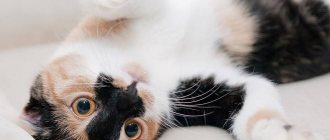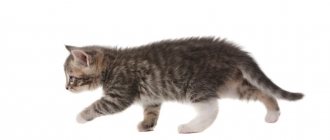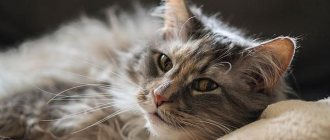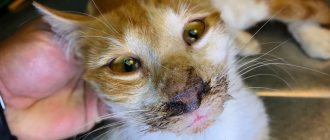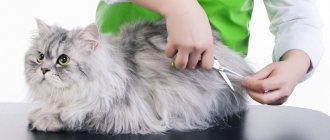A cat's increased attention to its ears is the first sign of otitis media. Inflammation in the ear cannot be ignored, otherwise it will affect the deeper parts of the hearing organ. This is fraught with hearing loss, and in especially severe cases can lead to the death of the animal. Therefore, let’s find out how different types of feline otitis media manifest themselves and what medications veterinarians recommend using to relieve inflammation.
Causes of otitis media in cats
According to statistics, parasites are considered the main causative agents of otitis media. Therefore, the appearance of fleas and subcutaneous and ear mites should alert every cat owner. By damaging the skin, they create a beneficial atmosphere for the development of pathogenic bacteria, which are formed as a result of the decomposition of tick corpses and their excrement. First, the disease affects the outer and middle ear, but gradually progresses and reaches the inner ear.
No less dangerous is allergic otitis in cats, which can be caused by an allergic reaction to the introduction of new food, the appearance of an external irritant, or to parasites. Like any allergy, the reaction is accompanied by severe itching and scratching of the skin, where infection subsequently occurs.
The cat's weak immunity and low body resistance make it practically defenseless against staphylococcus, streptococcus and trichophytosis bacilli, which leads to the development of the most severe form of this disease - purulent otitis of the inner ear.
It's no secret that cats love to climb trees, which often leads to injuries or scratches to the outer ear, against which otitis media can again develop.
In addition, the cat owner must remember that hypothermia and poor sanitation of the ears are also a harbinger of this serious disease.
Types of otitis
Otitis is a group of diseases that combine diseases associated with inflammatory processes in the ears. Depending on the course of the disease, they can be acute or chronic. The ear is divided into three parts - outer, middle and inner. And depending on the place of development of the inflammatory process, the disease occurs:
1) External form - localized in the superficial parts of the ear. Easily cured. 2) Medium form - descends into the lower parts of the ear, affecting the eardrum. Timely treatment starts guarantees a favorable outcome, otherwise it can take a chronic form. 3) Internal form - extends to the membrane and beyond. A severe form of the disease with purulent lesions, without treatment, leads to hearing loss, the development of meningitis and sepsis.
Otitis media in a cat develops in one or both ears.
Otitis in a cat: symptoms and signs of the disease
An attentive owner will always notice changes in the behavior of his pet if he knows the main symptoms of otitis media of the inner ear. The most common are the most visually identifiable signs:
- Irritation and redness of the skin of the sore ear, in which the cat periodically rubs it and at times applies it to the head;
- Acute pain provokes a sharp jumping up, screaming of cats, frightened looking around, the cat does not allow touching the head;
- Constant itching and the appearance of ulcers and scratches in the ear area;
- Shaking the head and lack of auditory response to the affected side;
- Possible drooping of the eyelid in case of damage to the facial nerve;
- The appearance of a characteristic cloying odor;
- Discharge from the ear with purulent otitis media;
- By bending over to your pet, you can listen to the characteristic gurgling and squelching sounds;
- Loss of appetite and cheerfulness;
- Heat;
- Irritability, constant meowing and screaming
Due to the slow development of otitis, in some cases, despite minor deviations in the cat’s behavior, a trip to the veterinary clinic is the optimal solution for quick rehabilitation and treatment of the pet.
Treatment methods
After examining the cat with an otoscope and taking material from the ear, the veterinarian will prescribe preliminary treatment. It will be adjusted once the test results are received. The regimen and tactics of therapy will depend on the reasons that contributed to the onset of the inflammatory process.
If the disease is mild and the pet’s life is not in danger, then it is treated at home. In severe cases, when there are symptoms of intoxication or there is a risk of developing meningitis, it is better to leave the cat in a hospital under the supervision of a doctor.
Standard treatment includes:
- pain relief – most often this is an injection;
- cleaning the ear canals from pus and crusts;
- injection of medicinal drops into the sore ear;
- For purulent otitis, the cat is prescribed a course of antibiotic injections.
A sick pet must be provided with complete rest. It is kept in a warm, draft-free place.
Therapy tactics
Regardless of the cause of inflammation, treatment of otitis in a cat begins with eliminating the symptoms. If only the outer ear is affected, then the shell is wiped with a special lotion and lubricated with wound-healing ointment daily until complete recovery.
For otitis media, veterinarians prescribe anti-inflammatory drops and painkillers by injection. It is important to provide your cat with adequate nutrition. Vitamins are added to the food to support immunity.
For purulent otitis, veterinarians prescribe local broad-spectrum antibacterial drops with anti-inflammatory and analgesic effects, as well as vasoconstrictor drugs. They relieve swelling, so pus comes out of the ear freely.
Attention! To prevent the cat from scratching its ears, a protective collar is put on during treatment.
Surgical intervention is not necessary if the eardrum is perforated or if a tumor is found in the ear.
Specific treatment
After receiving the test results, the veterinarian may change the treatment regimen and tactics. From now on, medications will be selected taking into account the primary cause of ear inflammation:
- If ear mites are the cause of otitis, the cat will be prescribed acaricidal drops.
- If a fungal infection is detected, the doctor will recommend antifungal medications.
- If the disease occurs due to allergies, antihistamines will be included in the treatment regimen.
- If there is a hormonal imbalance that leads to inflammation in the ears, it is recommended to take corticosteroids.
- To treat otitis media complicated by a bacterial infection, the doctor will prescribe antibiotic injections plus antimicrobial drops.
Medicines for the treatment of otitis media
All types of otitis are treated comprehensively. The following groups of drugs are usually used in the treatment of ear diseases:
- hygienic lotions for cleaning sinks;
- antimicrobial solutions for external treatment;
- wound healing ointments;
- analgesic, vasoconstrictor, antifungal, acaricidal and antibacterial drops;
- complex action antibiotics in the form of injections;
- antihistamines.
Since the main reason for the development of otitis media is a weakened immune system, many veterinarians recommend including immunostimulating drugs in the treatment regimen.
Most often, for otitis media, the following drugs and medications are used:
- Antiseptics for external treatment - a solution of furatsilin, boric acid or hydrogen peroxide.
- Wound healing ointments with antimicrobial effect - Levomekol, Safroderm.
- Drops with analgesic and anti-inflammatory effects - Otipax and Otinum.
- Antimicrobial drops - Anandin, Polyseptin, Otibiovet, Otibiovin, Sofradex.
- Antifungal drugs - MykoStop.
- Drops for parasitic otitis – Decta and Amitrazine.
- Combined drugs for the treatment of complicated otitis, including parasitic ones - Otospectrin, Tresaderm, Otidez, Oritsin, Surolan.
- Antihistamines are used for otitis of an allergic nature - these are Cetirizine, Tavegil, Loratadine.
- For bacterial otitis, cats are prescribed intramuscular injections of antibiotics - Amoxiclav, Cefixime or Ceftriaxone. The dosage is determined by the veterinarian taking into account the weight of the animal. Treatment lasts 7 days.
Purulent otitis in cats treatment
The disease at this stage is less treatable and there are frequent cases of surgical intervention or novocaine blockade to eliminate pain. A veterinarian also prescribes a course of antibiotics for a sick cat, vitamin therapy, ear rinsing, and strict adherence to a diet.
In a more simplified form, treatment at home is acceptable, subject to strict adherence to all doctor’s instructions. It is especially important before starting any therapy to identify the root cause of otitis media and eliminate it, only then will it be possible to achieve positive results.
Features of using ear drops for cats
Medicines against otitis media and parasites act quickly and efficiently. The main thing is to strictly follow the dosage and rules for applying the drug. Each pet has its own character. One animal calmly tolerates medical manipulations, while another cannot be restrained to instill the drug in the ears or on the withers. To ensure everything goes well, follow these recommendations:
- Wrap the cat in a towel, leaving the head and neck area exposed (safest method). You need to hold the animal very tightly so that it does not escape and scratch others.
- Clean the ears from exudate and crusts or disinfect the neck area.
- Place the required amount of drops into the ears or, using your fingers to part the fur, apply to the skin in the neck area or between the shoulder blades.
- Wear a head collar to prevent your cat from licking the medicine or rubbing it off with her paws.
- Temporarily isolate the animal from other pets so that they do not accidentally lick the medicine from the fur and become poisoned.
Treatment of otitis media in cats at home
If you have been diagnosed with otitis media in a cat, what to treat will be advised by an experienced veterinary clinic doctor who will professionally approach this issue and prescribe the most effective treatment. In most cases, a whole range of treatment procedures is prescribed, which must be carried out at a strictly defined time:
- Clean the inside of the ear from hair;
- Periodically remove purulent discharge and accumulated wax with a gauze cloth moistened with a special lotion for ear hygiene;
- Remove any remaining moisture and wait until the affected area is completely dry;
- Apply drops prescribed by the veterinarian and lubricate with ointment determined individually by the attending physician
To avoid the development of otitis media, you should adhere to preventive measures that will help minimize the risk of the disease.
First signs
First of all, changes will affect behavior. If a cat's ear is infected, it will begin to rub it regularly and shake its head. At these moments the head tilts towards the diseased organ. Associated symptoms: poor appetite, lethargy and inactivity. Upon examination, redness, an unpleasant odor, and ulcers are detected. If treatment is not started, the disease will become chronic. In this case, the symptoms temporarily stop, and later the disease affects uninfected areas with renewed vigor.
We recommend the article: Should I worry if my cat's whiskers fall out?
The pet's body temperature rises, vomiting, and behavior becomes distant. When you touch the ear, the cat may meow pitifully, because the pain intensifies every day. An advanced stage will cause convulsions and death of the animal.
Prevention of otitis in cats
- Strict adherence to the rules of maintenance and care;
- Regularly inspect the ear canal;
- Timely cleaning of the ear canals from wax;
- Avoid walking in damp, windy weather and severe frost;
- During water procedures, prevent water from getting into your ears;
- Avoid contact with stray cats;
- Disinfect your pet's toiletries weekly
Every cat owner must know that the slightest delay in contacting a veterinarian can cost your beloved pet hearing loss or even take his life.
Characteristic symptoms
Ear diseases in cats are manifested primarily by changes in behavior. You should watch your pet and if this happens constantly, then something is wrong with the animal:
- constantly tilts his head to the side;
- shakes his head;
- twitches his ears sharply, as if they were splashed with water;
- often and suddenly rubs the ear with a paw;
- presses his head against upholstered furniture, against the carpet;
- does not allow ears to be touched, runs away when the head is stroked;
- scratches the ears often and strongly, resulting in bruising;
- loses orientation in space, when walking the cat is constantly pulled to the side.
If this behavior is noticed in your pet, you should carefully examine the inside of the ears. There may be redness and ulcers in the ears, light or dark discharge, dirt in the form of dark crumbs, bloating and swelling. The diseased ear may smell unpleasant, and when you lightly press on its base, a sound similar to squelching can be heard.
Changes can occur in one or two ears at once.
If you notice that your cat’s ear itches or hurts, and she is worried, and any discharge or changes inside the auricle are detected, then the question arises - what to do and how to treat. There are many ointments, drops and lotions, but they cannot be used without clarifying the diagnosis. If they can cure one disease, then in another case they can cause harm and waste time.
If your cat has ear pain, you should find out how to treat it at home from a qualified specialist after conducting a series of examinations.
